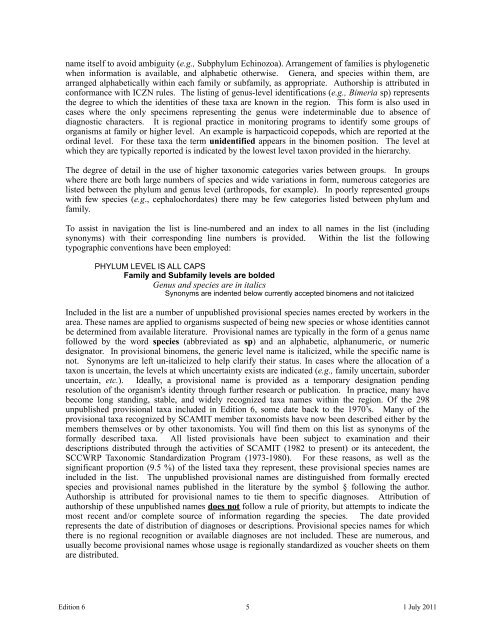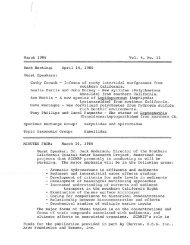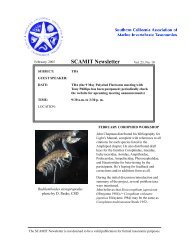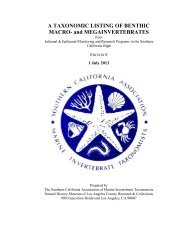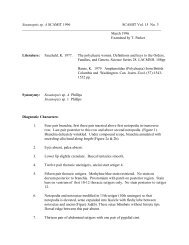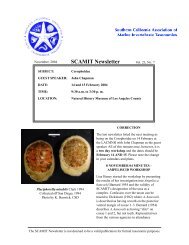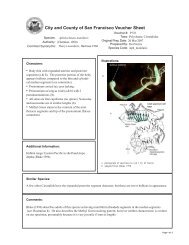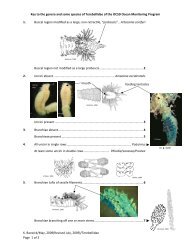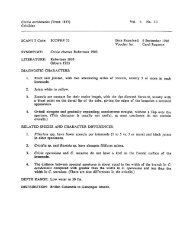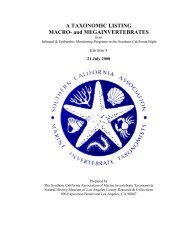Download - scamit
Download - scamit
Download - scamit
Create successful ePaper yourself
Turn your PDF publications into a flip-book with our unique Google optimized e-Paper software.
name itself to avoid ambiguity (e.g., Subphylum Echinozoa). Arrangement of families is phylogenetic<br />
when information is available, and alphabetic otherwise. Genera, and species within them, are<br />
arranged alphabetically within each family or subfamily, as appropriate. Authorship is attributed in<br />
conformance with ICZN rules. The listing of genus-level identifications (e.g., Bimeria sp) represents<br />
the degree to which the identities of these taxa are known in the region. This form is also used in<br />
cases where the only specimens representing the genus were indeterminable due to absence of<br />
diagnostic characters. It is regional practice in monitoring programs to identify some groups of<br />
organisms at family or higher level. An example is harpacticoid copepods, which are reported at the<br />
ordinal level. For these taxa the term unidentified appears in the binomen position. The level at<br />
which they are typically reported is indicated by the lowest level taxon provided in the hierarchy.<br />
The degree of detail in the use of higher taxonomic categories varies between groups. In groups<br />
where there are both large numbers of species and wide variations in form, numerous categories are<br />
listed between the phylum and genus level (arthropods, for example). In poorly represented groups<br />
with few species (e.g., cephalochordates) there may be few categories listed between phylum and<br />
family.<br />
To assist in navigation the list is line-numbered and an index to all names in the list (including<br />
synonyms) with their corresponding line numbers is provided. Within the list the following<br />
typographic conventions have been employed:<br />
PHYLUM LEVEL IS ALL CAPS<br />
Family and Subfamily levels are bolded<br />
Genus and species are in italics<br />
Synonyms are indented below currently accepted binomens and not italicized<br />
Included in the list are a number of unpublished provisional species names erected by workers in the<br />
area. These names are applied to organisms suspected of being new species or whose identities cannot<br />
be determined from available literature. Provisional names are typically in the form of a genus name<br />
followed by the word species (abbreviated as sp) and an alphabetic, alphanumeric, or numeric<br />
designator. In provisional binomens, the generic level name is italicized, while the specific name is<br />
not. Synonyms are left un-italicized to help clarify their status. In cases where the allocation of a<br />
taxon is uncertain, the levels at which uncertainty exists are indicated (e.g., family uncertain, suborder<br />
uncertain, etc.). Ideally, a provisional name is provided as a temporary designation pending<br />
resolution of the organism's identity through further research or publication. In practice, many have<br />
become long standing, stable, and widely recognized taxa names within the region. Of the 298<br />
unpublished provisional taxa included in Edition 6, some date back to the 1970’s. Many of the<br />
provisional taxa recognized by SCAMIT member taxonomists have now been described either by the<br />
members themselves or by other taxonomists. You will find them on this list as synonyms of the<br />
formally described taxa. All listed provisionals have been subject to examination and their<br />
descriptions distributed through the activities of SCAMIT (1982 to present) or its antecedent, the<br />
SCCWRP Taxonomic Standardization Program (1973-1980). For these reasons, as well as the<br />
significant proportion (9.5 %) of the listed taxa they represent, these provisional species names are<br />
included in the list. The unpublished provisional names are distinguished from formally erected<br />
species and provisional names published in the literature by the symbol § following the author.<br />
Authorship is attributed for provisional names to tie them to specific diagnoses. Attribution of<br />
authorship of these unpublished names does not follow a rule of priority, but attempts to indicate the<br />
most recent and/or complete source of information regarding the species. The date provided<br />
represents the date of distribution of diagnoses or descriptions. Provisional species names for which<br />
there is no regional recognition or available diagnoses are not included. These are numerous, and<br />
usually become provisional names whose usage is regionally standardized as voucher sheets on them<br />
are distributed.<br />
Edition 6 5 1 July 2011


